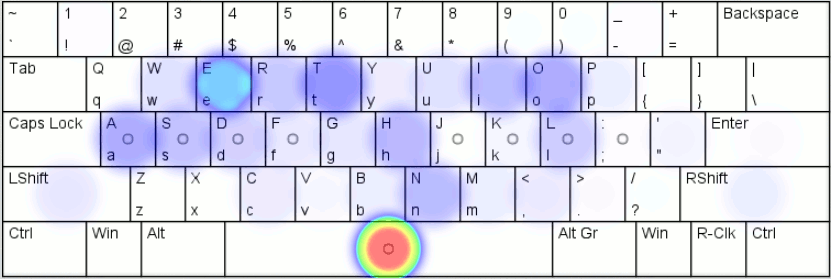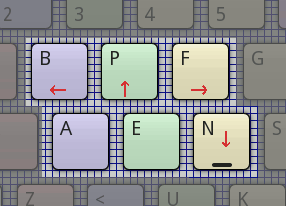- Fix QWERTY problems (apply solutions from well known alternative layouts).
- Place keys for general Emacs combos into easily accessible places instead of remapping them in Emacs.
Commonly the most of alternative layouts solve only first problem
mentioned above: they help you avoid ergonomic problems of QWERTY. But
they are require you remap the most of frequently used in Emacs keys
because these layouts was made without Emacs in mind. For example
several well known layouts try to keep XCV keys in the same place as
QWERTY because historically many applications on the desktop platforms
(Windows, Mac, Linux) had used these keys for clipboard operations. So
this is a strong habit of computer users that even alternative layouts
wont break it. But Emacs uses other keys for clipboard by default:
Ctl-W for cut, Meta-W for copy and Ctl-Y for insert. I
think these keys badly placed on QWERTY. But on Dvorak layout they
placed even worse on my sense. Norman layout places them in more
accessible places though. But anyway alternative layouts targeted at
mostly used apps (like word processors and well known browsers) those
keyboard combos very different from habits suggested by Emacs. So my
try is create the layout oriented primarily on Emacs experience.
The same problem appears for Emacs navigation keys on alternative layouts. So if you want to use better keyboard layout you will need adapt for the layout all your Emacs bindings and bindings in the applications that use Emacs-like bindings (shell for example).
I think the usable keyboard layout for all purposes is a mythical idea similar to idea of the universal programming language. A degree of usability always depends on UI of applications you use. Different apps have different frequency of key combinations and provide different hotkeys. Human languages beside English increase complexity of this task by adding their own rules of keys frequency that unique per each language. Also the hardware limits of common keyboards prevent to use them ergonomically (there are a very small set of keyboards that may be called really ergonomic).
But I think with all these limitations in mind it is possible to increase usability of your keyboard for the applications that we use most often for the one selected natural language. So the results for example for a person who most of the time write texts and presentations in office applications under MacOS will totally different against programmer who most of the time uses Vim and text utilities under Linux. There are no common optimal keyboard layout for them. But when people use nearly same set of applications and speak the same language then layouts would be similar too. So it is main idea of this project — it is not possible get universal ergonomic layout for all purposes but it possible to make nearly ergonomic layout for the people who uses the same tools.
It main cause why I not use one of ready alternatives and research for my own solution. In my everyday work of computer I use GNU/Emacs and terminals with Emacs-like keybindings. I also try to set Emacs keybindings in other programs where possible. And most of time I wrote texts in English for programming languages and documentation. So with Keymacs I could get layout better for many parameters than QWERTY and get keys placement well suited for Emacs bindings.
So it is chance that if you use Emacs and apps with Emacs-like bindings then my keyboard layout may be good for you too.
- Preferable usage of the home row (the factor for high optimization)
- Use English letter frequency statistics
- Minimize lateral movement on the most used bigrams and trigrams
- Minimize same finger usage on the most used bigrams and trigrams
- Equal effort for both hands
There are results from patorjk.com/keyboard-layout-analyzer for the configuration keyboard-analyzer-config.json:
Compare with QWERTY layout:
The tables below consists of n-grams (for n=2..4) sorted by popularity in English texts. It presents results for for Keymacs, Norman, Colemak, Dvorak (Programmer variant) and QWERTY layouts that reflect two aspects:
- all the letters of n-gram placed in Home Row
- all the letters of n-gram didn't require finger movement
If the conditions for the layout succeeded then it marked with X so more Xs are better.
| Bigram | Keymacs | Norman | Colemak | Dvorak | QWERTY |
|---|---|---|---|---|---|
| TH | X | X | X | ||
| HE | X | X | X | ||
| AN | X | X | X | X | |
| IN | X | X | X | X | |
| ER | X | X | |||
| ND | |||||
| RE | X | X | |||
| ED | |||||
| ES | X | X | X | ||
| OU | X | ||||
| TO | X | X | X | X | |
| HA | X | X | X | ||
| Total | 8(best) | 7 | 6 | 8(best) | 0(worst) |
Suchwise in Keymacs 8 of 12 for the most frequent bigrams placed in home row without finger movement. Dvorak has the same result for the finger movement.
QWERTY is the worst case with the finger movement reqiured for all mentioned bigrams and no frequent bigrams in home row.
The same test for the most frequent trigrams:
| Trigram | Keymacs | Norman | Colemak | Dvorak | QWERTY |
|---|---|---|---|---|---|
| THE | X | X | X | ||
| AND | |||||
| ING | |||||
| HER | X | ||||
| HAT | X | X | X | ||
| HIS | X | ||||
| THA | X | X | X | ||
| ERE | X | X | |||
| FOR | |||||
| ENT | X | X | X | ||
| ION | X | X | X | ||
| TER | X | X | |||
| Total | 8(best) | 6 | 3 | 4 | 0(worst) |
In Keymacs 8 of 12 of the most frequent trigrams placed in home row without finger movement. Other compared layouts have lesser trigrams in home row.
QWERTY is the worst case with the finger movement reqiured for all mentioned trigrams. It has none frequent trigrams in home row.
At last results for the most frequent quadrigrams:
| Quadrigram | Keymacs | Norman | Colemak | Dvorak | QWERTY |
|---|---|---|---|---|---|
| THAT | X | X | X | ||
| THER | X | ||||
| WITH | |||||
| TION | X | X | X | ||
| HERE | X | ||||
| OULD | |||||
| IGHT | |||||
| HAVE | |||||
| HICH | |||||
| WHIC | |||||
| THIS | X | ||||
| THIN | X | X | |||
| Total | 5(best) | 4 | 1 | 1 | 0(worst) |
In Keymacs 5 of 12 of the most frequent quadrigrams placed in home row without finger movement. It followed by Norman layout with 4 of 12 matches. Other compared layouts have less quadrigrams in home row.
In Keymacs most of time you will use home row of your keyboard (carpalx simulator shows >70% of home row usage on default corpus of English texts).
I strongly recommend remap Control keys in upper rows instead of
placing defaults in lower row. For example on my Lenovo I did remap to
CapsLock for LCtl and to Enter for RCtl. So they placed on
left and right side of home row now (and Enter was moved to original
Ctl keys). It depends on a keyboard model.
You would like remap Alt keys too because Meta key (that called
Alt on PC keyboards) is very actively used in Emacs.
Emacs by default uses holding Control and pressing F B for
navigating right-left and P N for navigating up-down. It is easy
for remember because of mnemomic names but badly placed in
QWERTY. Keymacs places all these keys for one hand usage (under a left
hand). Statistically the most used navigation key in Emacs is moving
cursor down so it placed in home row without a finger movement (N).
The block of navigation keys includes A and E that used in Emacs
for moving to the beginning or to the end of line.
Well it may look a bit alien. But it is no more alien than Vim' HJKL
:) With remapped Ctl keys (like described in a paragraf above) it is
comfortable with no matter which hand used for pressing Ctl. I
specially placed up/down arrows with horizontal shift so you can press
down arrow with index finger on home row and up arrow with middle
finger. Contrary to traditional placement of up/down arrows on
additional keyboard where you need use the same middle finger for both
keys.
For the list of the most often pressed key combinations in Emacs I used statistics results from ergoemacs.org/emacs/command-frequency.html.
This my research for the best keyboard continues for a long time. I had tried different well known alternatives like Colemak and Workman and after that started with my custom keyboard in 2014 (link to the previous effort). I am still using it. After all it is far from finish. Though I already got much more comfortable layout for my needs than default but it still has a lot of drawbacks. So I can't recommend to use it yet. But I hope my results may inspire you to find your own right path to the ideal.
Though I mostly satisfied with letters there are many place for improvement for numbers placement and non-letter symbols. So the layout continues to evolve.
Keyboard effort
------------------------------------------------------------
k1 0.790 78.4 78.4
k1,k2 0.980 18.8 97.2
k1,k2,k3 1.008 2.8 100.0
b 0.336 18.6 18.6
p 0.672 37.3 149.9
ph 0.000 0.0 0.0
pr 0.166 24.7 24.7
pf 0.431 64.1 88.8
s 0.795 44.1 100.0
all 1.803 100.0 100.0
#data effort_k1=>[0.790,78.380,78.380],
#data effort_k12=>[0.980,18.832,97.212],
#data effort_k123=>[1.008,2.788,100.000],
#data effort_base=>[0.336,18.616,18.616],
#data effort_penalty=>[0.672,37.288,149.924],
#data effort_penalty_hand=>[0.000,0.000,0.000],
#data effort_penalty_row=>[0.166,24.693,24.693],
#data effort_penalty_finger=>[0.431,64.134,88.827],
#data effort_path=>[0.795,44.096,100.000],
#data effort_all=>[1.803,100.000,100.000],
keyboard row frequency
------------------------------------------------------------
1 1483367 16.2 16.2
2 6734080 73.6 89.8
3 933718 10.2 100.0
#data row_data=>[qw(1 2 3)],
#data row_frequency=>[0.162,0.736,0.102],
#data row_cumulative=>[0.162,0.898,1.000],
keyboard hand frequency
------------------------------------------------------------
0 4634796 50.6 50.6
1 4516369 49.4 100.0
#data hand_data=>[qw(0 1)],
#data hand_frequency=>[0.506,0.494],
#data hand_cumulative=>[0.506,1.000],
keyboard finger frequency
------------------------------------------------------------
0 539877 5.9 5.9
1 895424 9.8 15.7
2 1540730 16.8 32.5
3 1658765 18.1 50.6
6 1806945 19.7 70.4
7 1211914 13.2 83.6
8 918154 10.0 93.7
9 579356 6.3 100.0
- Layout has high rate of consecutive finger usage for index fingers.
- Navigation block need more research (all keys ←↓↑→ on one hand VS splitted ↓↑ on left and ←→ on right).
See Control Layer.
One thing that I know today — the keyboard layout optimization is endless process :)
I mostly satisfied with current results. In 2017 I moved to Ergodox EZ keyboard and adapted Keymacs layout to it. It looks like this.
This work dedicated to the public domain.




